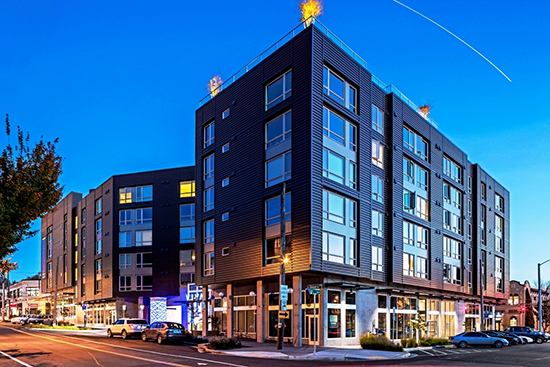|
Subscribe / Renew |
|
|
Contact Us |
|
| ► Subscribe to our Free Weekly Newsletter | |
| home | Welcome, sign in or click here to subscribe. | login |
Construction
| |
 |
April 30, 2015
ABC Awards • Multifamily Construction

Viva
Synergy Construction
Architect: BCRA
Engineer: Quantum Engineers
Owner: Alliance Residential
ABC members: Ahlers & Cressman; Construction Industry Training Council of Washington: Creative Surveillance Solutions; Dexter + Chaney; Merit Mechanical; Pacific One Construction; Propel Insurance; Safety Matters; Schmitz & Associates; Sound Glass Sales
Viva is a 105-unit apartment building on a 14,000-square-foot triangular lot at the intersection of Union and Madison streets in Seattle.
The six-story building has two levels of underground parking, street-level retail space and five levels of apartments above. The structure was constructed with three levels of post-tensioned concrete and five levels of wood framing. Its exterior cladding system includes a fluid-applied air and water barrier extending over the entire building surface, metal panel siding, and a storefront glazing system at the retail level.
Challenges started early during excavation, when a number of unknown underground structures were found and had to be removed, impacting the schedule and extending excavation into the wet winter months. The site had also been home to a gas station, leaving contaminated soil that needed to be removed and remediated.
To make up time, Synergy expedited the cast-in-place concrete schedule and increased wood framing crews that worked multiple shifts per day.
The site, in the heart of Capitol Hill and bordered on all three sides by busy arterials, had minimal space for staging, storage, or lay down during construction. Using the right of way meant renting it from the city at a premium price, so Synergy mitigated that cost by limiting the rented space to a single length of the project site and kept the remaining two sides open for pedestrian access.
The owner made significant design changes during the project, some that required long lead time deliveries. The team was able to present options to the owner to accommodate design changes to the lobby, modifying door and wall layouts, and adding access control and video monitoring.
The project was completed on time and on budget, and there were no medical or time-loss incidents during 22,400 hours worked.
Other Stories:
- Industry associations now have 3 generations of members
- ABC Awards • Infrastructure
- ABC Awards • Mechanical Construction
- ABC Awards • Specialty Contracting Interior
- ABC Awards • Tenant Improvement
- Survey: High Country Contractors & Developers
- Survey: Howard S. Wright
- Survey: Sellen Construction
- Survey: Schuchart
- Survey: McKinstry
- Survey: GLY Construction
- ABC Awards • Industrial Construction
- ABC Awards • Historic Preservation
- ABC Awards • Health Care
- Contractors face new risks with early design
- How to keep safe while working in a deep hole
- In dispute resolution, trained ‘neutrals’ are a plus
- Is your deck designed to handle a crowd?
- What is high-performance teamwork? Local leaders tell all
- Why it’s better to rent than buy Tier 4 equipment
- Eagle of Excellence • Mixed-Use Construction
- ABC Awards • Commercial Construction
- ABC Awards • Community & Public Service
- ABC Awards • Electrical & Communications
- Survey: Alston Construction


